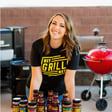The Role of Reviews in Business Trust
00:00:06
Speaker
and on something that's not particularly inexpensive, that we really need to bridge the trust gap. And so I think that reviews are going to be just absolutely crucial for us. So we wanted to, right off the bat, have a place that people could leave reviews and have them, you know, show up on the website.
Introduction to the Brands That Book Show
00:00:24
Speaker
Welcome to the Brands That Book Show, where we help creative service-based businesses build their brands and find more clients. I'm your host, Davy Jones.
Overview of FarmFedBox
00:00:36
Speaker
Today's episode is a fun one because I get to share a little bit about another business of mine that I haven't shared much about on this podcast, while also sharing some behind the scenes of the stack of tools that we're using to make that business's website work. The business is FarmFedBox, and you can learn more about it at farmfedbox.com.
00:00:57
Speaker
Just for some context for any new listeners, we recently moved to Virginia and started farming with good friends of ours. I know that sounds crazy, but we're primarily raising cattle, pigs, and chickens using sustainable farming practices. But what we're actually reviewing in today's episode is how we set up our subscription box website and specifically what tools we're using to make it work behind the scenes.
Engaging with Listeners and Feedback
00:01:20
Speaker
Be sure to check out the show notes at davianchrista.com for the resources we mentioned during the episode, and we want to hear from you. Let us know what kind of content you'd like to see on the Brands That Book podcast as we move forward. To leave your feedback, just send us a DM on Instagram at davianchrista.
FarmFedBox Giveaway Announcement
00:01:34
Speaker
And if you are interested in receiving a box of pasturates, beef, chicken, and pork delivered straight to your door each month, be sure to check out farmfedbox.com. We're actually giving away a subscription this week, and you can learn more about the details of our giveaway on Instagram at farmfedbox.
00:01:50
Speaker
Our next shipments go out next week. Now onto the episode. All right, I'm excited about today's episode. A little bit different than what we usually do. Yeah, definitely different. I mean, I don't think that we have ever talked about physical products very often. And then today's physical product is kind of a unique physical product.
00:02:12
Speaker
Yeah, for sure. And so, and I mean, just a lot of the content focusing on service based businesses, primarily, we don't talk a ton about online businesses. And, you know, if you're interested more in online business talk, you know, we have another podcast through till agency called stuff marketers say where we cover a lot of that. But today we're talking about launching a subscription box website.
Launching a Subscription Box Website
00:02:33
Speaker
And it's for, you know, is exciting to launch one because it was the first subscription box website that I helped build.
00:02:40
Speaker
Alright, and then it was also exciting because it was for one of my businesses. So as many listeners of the podcast already know, I'm obviously a part of baby and Krista. But then also the till agency where we do digital ads and search engine optimization. But I'm actually part of a third business called farm fed box.
00:02:59
Speaker
You can learn more about that over at farmfedbox.com. That's a business that we're talking about today. I want to talk about a little bit of the behind the scenes in setting up that website, review a few of the tools that we use to make sure that this website effectively operates as a subscription box website.
00:03:18
Speaker
And I think it's gonna be, you know, it might not be immediately relevant or not, maybe all parts of it won't be immediately relevant for, you know, a service-based business, let's say, or, you know, I guess maybe the typical business of a listener who listens to this podcast.
Website Relevance for Service-Based Businesses
00:03:33
Speaker
But I think that there are different parts of this process building this website that I think are relevant. And you might walk away with, you know, maybe one, a new tool that you can use in your business,
00:03:44
Speaker
Or two, just some ideas of ways that you can kind of appropriate a concept for your business. Yeah, definitely. I mean, especially if you've ever considered starting an online shop, I know that there probably aren't that many listeners who want to start exactly what you did. So a subscription box that people get every month. But there might be pieces that you thought about for e-commerce that people have never considered, especially some of the tools that you integrated. So I'm excited to chat about those.
00:04:12
Speaker
Yeah, absolutely. So I guess first I should just kind of explain what it is. Yeah. So I mentioned the website, farmfedbox.com. And if you go over to farmfedbox.com, hopefully you'll see sort of right away that it's a monthly 15-pound box of meat, all right? So we're shipping a monthly 15-pound box of pasture-raised beef, chicken, and pork, all that was raised here on our farm. And I'm not sure. I think
00:04:36
Speaker
I think in a couple of past episodes for people who've listened, I've mentioned the farm before. I think you've probably talked about the pigs and maybe our chickens. Of all the animals, right, that's the kind of where most of my chores are centered. But anyways, so I've definitely talked about on the podcast, but as you can imagine, I try not to talk about it too much because it's not super relevant to the content we usually share on this podcast.
00:05:02
Speaker
So anyways, it's a 15 pound box of pasture raised beef, chicken and pork. It's shipped monthly. We want people to be able to sign up anytime. And then beyond that, we just wanted to make sure that, I mean, there's a lot of questions around buying food. Is it non-GMO? Is it raised ethically?
Addressing Ethical Concerns of FarmFedBox
00:05:24
Speaker
All these different things. So those are all questions that we need to answer on the website. So where should we start?
00:05:30
Speaker
I think it might be helpful to talk about just some of the elements you needed to include on the website to even get people to buy your boxes. Yeah, no, that's a good place to start. So really what we wanted to focus on a few different things. One, I wanted to make sure that the website was visually appealing, you know, and I'd say... I mean, I did it, so check. Yeah, exactly. So, you know, we wanted to make sure it was visually appealing.
00:05:53
Speaker
I would say that just like the agricultural industry in general, there are some really great examples out there. There are a lot of examples that aren't so great and a lot of experiences that aren't so great. So we wanted to make sure it was visually appealing, easy to use. We wanted to make sure that there were elements for different content types such as like an FAQ section. We thought just right away that people are going to have a lot of questions.
00:06:18
Speaker
Is the feed that the animals eat, is it non-GMO? Are your cows grass fed and grass finished? How does it work? Things like that. So we wanted to make sure we had a robust FAQ section. A big one was that we wanted a place that people could leave reviews. And I think just for really any business, certainly a business that's new, social proof is so key. And especially if you're going to take a chance on something like food.
00:06:46
Speaker
and on something that's not particularly inexpensive right that we really need to bridge a trust gap and so i think that reviews are going to be just absolutely crucial for us so we wanted to write off the bat have a place that people could leave reviews and have them you know show up on the website right and that was something that you built into the site correct.
00:07:06
Speaker
Yeah, so there's a tool, and we can get into the specific tool that I used here in a minute, but we're using a tool that it's pretty awesome, automates the sending process in terms of the ask for the review. When people leave a review, it pops up straight on the website. It looks pretty good, at least compared to a lot of different review tools out there. Right. So that was something that I had to think through as well.
00:07:34
Speaker
Is that something that you would recommend most businesses do with their website? Or do you think that was specific for you and your business because it was a product? Yeah, that's a great question. I think that social proof, and we've talked about this before, how important social proof is in the purchasing experience. And I would say that a lot of social proof, whether it comes in the form of reviews or testimonials or places that you've been featured, whatever it might be,
00:08:02
Speaker
You know social proof really can cover a multitude of sins when it comes to your website, right? Because you know, we've all been on websites that are extremely popular that people purchase on all the time But they're ugly websites, right, you know, like Amazon is that beautiful? Yeah, but you know, like what is what's the one thing you look on an Amazon when you're looking at a new product your reviews exactly I mean I pretty much sort by reviews in prime and
00:08:26
Speaker
I look at the most relevant because some of them are negative and some are positive. So even like shopping yesterday for your birthday present, I was looking at different things and it's like, wow, there's a big mix in here. So I don't sort them. So I sort, you know, I go and filter them. So it's, you know, it has to be like, if I'm purchasing something, the first results I'm going to look at are four stars and above and Amazon prime.
00:08:47
Speaker
Okay, and that's how and that's pretty much how shop but I think regardless like people want to know that the product is going to work and specifically they want to know that the products going to work for them and one of the most powerful things about reviews is that you're getting your customers to talk about in their own words your product and how it worked for them specifically.
00:09:08
Speaker
And so, I can't think of a good example off the top of my head, but if we're trying to purchase a product, let's say, maybe a tool that we want to use for a specific use case, maybe that use case isn't specifically mentioned on their website, but then you come across a review and somebody's like, oh, I bought this tool and I used it for X and it worked perfectly. All of a sudden, that's going to instill a lot of confidence that, okay, well, that's a use case I wanted to buy it for, and so it'll probably work for me too.
00:09:36
Speaker
would you put this embeddable thing on a photography website? Yeah, that's a great question too. Probably not. Yeah, I agree. Yeah, I would say that. It depends on the photography website too and the type of photography. If all you did was the photo booths, your whole business was a photo booth business and it's something that's probably relatively low cost compared to hiring a photographer for a wedding or something like that.
00:10:05
Speaker
And people can go on and they can place their order and they don't necessarily have to talk to you about the photo booth before they, you know, quote unquote, order the photo booth, then yeah, you know, I would use it. But if you're a luxury level photographer, you know, that's probably, first of all, I doubt that your clients are gonna fill it out. And then two, like how it shows up on your website, it looks, it probably wouldn't fit your brand.
00:10:26
Speaker
Yeah, I'd probably, if I was more of a service based business, I'd probably still direct people to Wedding Liar, Google reviews, Facebook reviews, and then just pick snippets of what they say and put that on my website or email them personally, ask them questions, and then put the answers to their questions on my website.
00:10:44
Speaker
Yeah, and that's a good point because, you know, social proof isn't just reviews, right? So, if you get a testimonial for somebody like that counts as social proof, you can put that on your website. And that, you know, I think that kind of thing can still instill confidence in somebody. But also, just think about a luxury level photographer. If you're a luxury level photographer, like if I was starting a luxury brand, you know, photography business,
00:11:07
Speaker
I would be trying to get in with as many planners as possible. But even that, that relationship is a form of social proof. Because when that planner says to their client, like, hey, you have to book so and so, right? That referral there, that's a form of social proof in my book.
00:11:22
Speaker
Anyways, all that to say probably wouldn't fit on certain websites. We don't have something like that on Davy and Krista, although I could see maybe it being helpful around specific products. But in general, I would say, I think for this business, it's going to be integral. But it doesn't necessarily mean you have to have it for every business. Okay. What are some other things that you definitely needed to include on this website?
00:11:48
Speaker
Yeah, so we needed to make sure that we had a tool in place for both transactional emails and marketing emails. We talked a lot about on this podcast different marketing email platforms like Flowdesk and ConvertKit. Those would be examples of marketing emails. Transactional emails are those emails that, for instance, when you purchase something, you get an invoice. That's an example of a transactional email. Or if you're signed up to a service and they have to send a message about
00:12:15
Speaker
they're being downtime or about some sort of change in your order or whatever, that's a transactional email. Transactional emails, as long as you are subscribing to the service or you're a customer or whatever, you can't really unsubscribe from those. Marketing emails are the types of emails that you can unsubscribe from.
00:12:37
Speaker
And then beyond that, just account section where people could manage their membership. And then the biggest question mark, of course, was shipping. That was, I think, the area that required the most research and the most testing. Yeah. I mean, I've built many e-commerce sites now and shipping just isn't something that's kind of standard built into even like WooCommerce or Shopify. And so it takes a lot of extra work and a lot of extra plugins, I know, to figure out shipping.
Technical Setup for Shipping and Payments
00:13:04
Speaker
Yeah, and it's so different from business to business. First of all, I would say that it's not like there's a lot of businesses out there that are sharing how they do this kind of stuff. And there's not really a reason for them to be sharing about that kind of stuff.
00:13:21
Speaker
And the people who are teaching on it, they provide good info. If you just went to YouTube and looked up reviews of different shipping plugins, there's good content out there. But again, making sure, setting things up for your specific use case, that's where things get tricky. So we had to figure that out as well.
00:13:38
Speaker
Okay, so you just talked about a lot of different things. I think maybe it might be good for you to break down which platform you used to start with because we recently did an episode on WordPress versus show it. And there are even a lot of other e-commerce platforms out there. So which one did you choose for this business?
00:13:55
Speaker
Yeah, absolutely. And if you hear thunder in the background, a storm that was not forecasted is rolling through. But the rain is welcomed. Anyways, so we decided to go with Elementor and WooCommerce. And one of the reasons that we settled on Elementor was because we wanted to use WooCommerce.
00:14:19
Speaker
And even within WooCommerce, we wanted to be able to use like kind of the full range of WooCommerce tools. And so as you know, something that we talked about in the show versus Elementor podcast and YouTube video is that yes, show does work with WooCommerce, but sometimes you'll still be limited in terms of like what plugins then that are compatible. So we didn't really want to have to worry about that. Although we would have loved to use show it just because it's beautiful and easy.
00:14:46
Speaker
But we decided to go with Elementor WooCommerce. We looked at a number of different membership solutions such as MemberPress and Access Ally. We ultimately settled on WooCommerce memberships. And one of the reasons that we settled on WooCommerce memberships is because stuff like MemberPress and Access Ally really more focused on digital products.
00:15:06
Speaker
Right, like logging in and getting access to content. Exactly. So if we were releasing content and that was kind of central to the business model, then those would have been great tools. But we needed something that was actually to a certain extent simpler than that and could account for shipping. Again, shipping was the big question mark there. And we initially tried to make member press work, but there was going to have to be too many workarounds when it came to shipping.
00:15:29
Speaker
So WooCommerce, WooCommerce memberships, and that way we could set up even our product, our core product, the 15 pound box, as a product within WooCommerce. And it's just an area where we all feel really comfortable, I think. And by all, I mean me and you, who are doing primarily the website stuff and marketing stuff.
00:15:51
Speaker
By choosing WooCommerce, we could also use other tools that we knew would work well, one of them being WooCommerce subscriptions. Right. Explain what that does. Yeah, absolutely. WooCommerce subscriptions basically allows you to charge people periodically and you can set the intervals. For us, it's month to month or somebody could purchase an annual membership, which would renew each year.
00:16:15
Speaker
And it gets a lot more technical than that. You could say like initial payment is X and then every payment after that is X amount. Like it gets really intricate and fancy.
00:16:24
Speaker
Yeah. And there's a lot of really great for people who are doing some sort of membership, right? If you're using, if you decide to use WooCommerce memberships and maybe WooCommerce subscriptions with WooCommerce subscriptions, you can have a free trial. Like you said, you could charge an upfront fee and then a ongoing fee after that. So it's really, I think a pretty flexible subscription plugin. And it's premium, right? This one you pay for WooCommerce itself is free.
00:16:48
Speaker
Yeah, WooCommerce is free, but as anybody who's used Shopify or WooCommerce knows, or WordPress for that matter, like at the end of the day, you're going to end up paying for some of these tools like WooCommerce subscriptions, WooCommerce memberships, both you have to pay for. Another tool that we wanted to be able to, or another thing that we wanted to be able to do was provide people the option to gift memberships or gift boxes. So we had to get, I think it's WooCommerce gifts or whatnot.
00:17:16
Speaker
That's another paid tool. So a lot of the tools and a lot of these, they have free options. They're just going to be very limited. Yeah, they're going to be exactly. They're going to be very limited. So that's part of the reason we decided to choose, you know, go to the Elementor and then WooCommerce route. Okay. Do you want to talk about shipping? Because you probably had to add some extra software to get that to work, correct?
00:17:39
Speaker
Yeah, absolutely. And there's one thing that I didn't mess around with, and maybe I should have. And so maybe there's somebody out there listening that has shipping dialed in. Maybe you just come from a, that's your business. So I would love, I guess what I'm about to share about shipping is based on my research and kind of limited experience here. So if you have suggestions for us, feel free to send us an email or DMS on Instagram and let us know.
00:18:07
Speaker
But we decided to stay away from Jetpack. I know that Jetpack offers different shipping and tax solutions and things like that. In general, I've had a bad experience with Jetpack in the past and I feel like it places a lot of burden on your website resources from what I understand. So we stayed away from that and we looked into different options.
00:18:29
Speaker
What we ultimately decided and why this was part of the reason why this was, you know, kind of an issue figuring out is because, you know, the cost of shipping to California, for instance, is obviously far more expensive than shipping, you know, locally in the Mid-Atlantic area. Right. And you need to make sure it gets there by a certain time as opposed to like sending a t-shirt or a book, which
00:18:48
Speaker
I mean, people, it would be nice if it got there in like two days, but it doesn't normally need to be there in two days. Yeah, exactly, exactly. So, you know, when somebody, we needed basically there to be enough logic in our shipping solution so that if somebody was in the mid-Atlantic area where we can ship anything within one day, just ground, that's an option for them. Whereas anybody who's out in California, ground isn't an option because it would take a week to get there. And the meat, you know, at least some of the meat would go bad, right?
00:19:18
Speaker
So we really needed everything to get there within two days. So a lot of different things that we had to work through there. What we ultimately decided to settle on were two tools. Shippo, which is a tool we feel really good about and I'll talk more about in a second. Okay. And then the WooCommerce FedEx plugin. I'm sure there's something better out there than the WooCommerce FedEx plugin. It's pretty cool that FedEx has a plugin. So like does UPS have a plugin and USPS?
00:19:42
Speaker
I'm not sure. I didn't check for the UPS one in particular. And it's funny, we actually use UPS most of the time. So FedEx though, there was a plugin. So we, you know, that's part of the reason why we're going with FedEx. It was easy enough to set up and set shipping zones. So again, some of that logic was built in, like it could automatically
00:20:02
Speaker
you know, detect based on somebody's address, here are the options that you're going to give somebody. And we found that FedEx prices were very representative of the different shipping prices we can get. Okay. You know, so ultimately, Shippo is going to allow us to choose a carrier and, you know, print the label.
00:20:22
Speaker
And so FedEx basically allows for us to feel good about the price we're quoting the customer, but then also just make sure that everybody's getting kind of accurate information.
00:20:36
Speaker
If I live in Arizona and I'm ordering a meat box, is it FedEx that gives me the price estimate or is it Shippo? It's FedEx. It's FedEx. It's all based on FedEx's prices. Then once I place my order, you use Shippo to choose how you're going to do the label and the shipping.
00:20:52
Speaker
Exactly. Exactly. So that's why you did both. Yeah. And that's the other thing is carriers in different areas. There could be a better carrier to get it to you most efficiently. Okay. And so Shippo allows us to at a glance, all of that populates. So there's a connection between Shippo and our WooCommerce store.
00:21:10
Speaker
All of that order information populates in Shippo. I can easily print bulk labels if I need to, but then I can also go into each order and I can say, okay, this is the best fit for these different orders. Okay, that's really cool. Yeah, and it gets a little bit more complicated than that, but we don't have to get into that on a podcast where people can't actually see what we're talking about. And are these like a monthly fee or an annual fee?
00:21:37
Speaker
That's a good question. So Shippo has a free option where you then pay per label at a certain point that doesn't make sense and you jump up to a different plan. But I want to say their first paid plan starts at something like $10 a month. The FedEx plugin definitely costs, as all these WooCommerce plugins seem to, I think the FedEx plugin was somewhere in the ballpark of $50 or $100 a year. Which is pretty standard for a WooCommerce extension plugin.
00:22:03
Speaker
Yeah, you're looking at, I feel like for most extension plugins for WooCommerce, you're looking at $50 to $100 a year. And again, it's annual versus monthly. Whereas I think, and I don't have as much experience with Shopify, but I feel like a lot of Shopify tools were monthly.
00:22:20
Speaker
I think in Shopify itself, the cheapest version is $9 a month or something even to start and then to add any of the things that we've just talked about, you're adding at least once a month another payment. Yeah. Well, anyways, we can move on from shipping. So where should we go next? Do you want to explain this fancy reviews tool that you
Managing Product Reviews with Judge.me
00:22:41
Speaker
Yeah, absolutely. The tool that we decided to use is called Judge.me, which I think is a witty name. It is clear. If you go to Judge.me, you can see the tool that we're using. Judge.me was apparently originally created for Shopify. If you use it on Shopify, there's a free version and there's a paid version. If you use it on WooCommerce though,
00:23:05
Speaker
The version you get is the free version, but it is the premium version. That's cool. So you get the premium features for free on WooCommerce. At least for now. Yeah, at least for now. And the only reason I know that is because I don't feel like I saw this on their website. I started using the tool, got it all set up, tested it, was like, this is awesome. I'm definitely going to upgrade to the premium plan.
00:23:31
Speaker
And so I emailed them, I'm like, I can't find an upgrade button, how do I upgrade? And they're like, oh, you already get it since you use, it's free on WooCommerce. And I was like, that's amazing. That's amazing. Yeah, I mean, with that said, I want to say that their awesome plan or whatever they call it is only $10 a month. So it's relatively inexpensive as far as website tools go.
00:23:52
Speaker
And how does it look? I feel like that's a key component. Well, you've seen it, right? Haven't you seen it? Yeah. But the podcast listeners just haven't seen it, probably. Yeah. Well, I was saying you could answer that question. I think it looks pretty good. There's a fair amount of customization that you can do. I mean, it's not like you can design exactly how it looks, but you can keep it simple enough where it certainly doesn't distract from your website.
00:24:15
Speaker
So our setup for it is pretty simple, just in terms of aesthetics, like how it looks. And then the automated emails that you send, you can set up, like you can customize the email template. So it has all of our colors and our fonts and things like that. It still looks like an automated email, you know, like it doesn't look like something you would send out a flow desk, but it's still, it still looks pretty good. And those come in, like, if I leave a review, I'm guessing you sound like an automated thank you or something.
00:24:41
Speaker
Yeah, so what happens is, I mean, there's all sorts of things you can do with it. Just to sort of scratch the service here, if you order a box, once that order is marked as completed, it's going to show up in our reviews dashboard. You as a customer who could potentially leave a review. That's very cool. Yeah, we've sent increments, time intervals, when you'll get a notification to actually go leave a review. So that's all automated.
00:25:06
Speaker
You can send it manually, so I could go in there and hit send now, and it would send you the email that says, hey, you recently received this box, we hope you loved it. Would you mind leaving a review? It will help other customers make their decision, or something along those lines. So, and all of that can be customized. Okay. And there's even more that it does beyond that, and I'm trying to think some of the other, like, for instance, picture reviews, you know, if someone wanted to upload pictures, we didn't want to go that route because I just feel like that looks...
00:25:34
Speaker
It doesn't look great. I can tell you that meat is not easy to photograph. Yeah, exactly. Because I took all of your product shots. And there's other things that it can do, so I'm sure we're just scratching the surface with it. But it was super easy to set up, and I was just really impressed with it. Also, I had to jump on with support once or twice just as I was figuring things out. I mean, somebody answered right away. That's awesome. Yeah, it was like an in-app chat, that sort of thing. So it was good.
00:26:01
Speaker
So if you have a physical products WooCommerce shop, would you say that this is better to use than like the standard built-in reviews into WooCommerce? Oh, 100%. Yeah, 100%. And this is one area where I probably looked at to 12 different tools before making up my mind. I didn't download and install all 10 to 12 tools, but I did a fair amount of research on this before getting it set up. I think that's all I have to say about Judge Me.
00:26:27
Speaker
Okay, very cool. All right, from marketing emails, what did you end up using?
Email Marketing with Flodesk
00:26:33
Speaker
Yeah, so we went with Flowdesk. Cool. So again, you know, I went back and I listened to our podcast episode comparing ConvertKit and Flowdesk. You know, I think one of the things that I really like about Flowdesk that made it an easier decision was it's beautiful, right? And so we're able to send emails that look visually appealing. There is, you know, I know we're not a creative business, you know, in the same way like that they created, you know, at least in the same vein,
00:26:57
Speaker
that the creative businesses that we serve are, right? But there is a lot to show off. We have this beautiful farm, so there is an imagery aspect to what we do for sure. Right, I mean, two of your wives were photographers, so we give you great visuals. Yeah, exactly.
00:27:13
Speaker
So there is, you know, so that was one of the reasons. And the other thing is like, you just can't beat, I mean, it's $20 for unlimited emails, unlimited subscribers. And I want to mention, I think they're getting rid of that beta price at some point this year. I don't know that for sure. Okay. I don't know that for sure. So you can do a double check. I mean, that price can't be beat.
00:27:33
Speaker
Right. So if you want a mailing list and you haven't signed up for any software yet, sign up for Flowdesk now. Exactly. Yeah. And we can include a link in the show notes for you to do that. Yeah. Because if you sign up with somebody else's link, it's only $20 forever for you. But if you just sign up on their site, I think it's $40.
00:27:51
Speaker
40 or 49, I can't remember. Yeah, it's more. So the only downside about choosing Flodesk though is that we needed to use Zapier to integrate Flodesk and WooCommerce. But with that said, you actually need Zapier to integrate ConvertKit and WooCommerce now that I think about it. Yes. Yeah. And so you're probably going to end up having to get the WooCommerce Zapier plugin so that you can use Zapier. Which is paid? Yeah, just it's another paid plugin. There are lots of free WordPress plugins out there.
00:28:19
Speaker
I mean, I have a very specific way that I wanted to build this website, but I will say if you want to use Zapier, you have to use the WooCommerce Zapier plugin. Okay. Like it just, you can't get around it. And so this, when I buy a box, that's how my email gets added to your list through Zapier.
00:28:36
Speaker
Is that why you had to do it? Yeah, so basically when you buy a box, right? And this will be used for like leads too, of course, but like we want when you buy a box for you to get certain emails that will hopefully make your experience better. Like just letting you know what to expect, maybe sending you some recipes, you know, letting you know just simple things about the box. Like, hey, if you're not going to use this meat in a week, you know, whatever you're not going to use in a week, you should go in the freezer, right? You know, things like that. So that's one of the reasons why we needed Zapier.
00:29:05
Speaker
Okay. But Zapier is just helpful to have. And honestly, if you're a business long enough, you'll probably end up using it for something. Oh my gosh. We have so many zaps in our Zapier account. Zapier just allows you to link two tools that don't natively integrate with each other. Yes. So for anybody wondering.
00:29:21
Speaker
For transactional email deliverability, we signed up for a SMTP account. And basically, again, transactional emails are just those emails that are triggered from transactions. And technically, they're all built into WooCommerce, but we have found that they don't always get delivered right unless you added an asset. And can you explain what an SMPT is?
00:29:42
Speaker
Yeah. So just to just to review that real quick, but there's a lot of different tools that you can use for, there's a lot of different tools that you can use for transactional emails. I don't think I could get into the nuts and bolts of the, of what SMTP is, you know, it stands for simple mail transfer protocol. All right. Um, and the gist of it, I think what people need to know is that ensures that your email actually gets to the recipient.
00:30:08
Speaker
Right. And so, you know, for instance, on the WordPress side of things, a popular plugin is, and I can't remember exactly, but it's SMTP, something like Mail... Mailgun? No. Mailgun's another... Mailgun's a name of a company that provides, you know, like email services or whatnot.
00:30:29
Speaker
We'll link to it in the show notes for people if they want to check out what SMTP plugin we used, but it's connected to an actual SMTP account as well. Anyways, long story short, we use that for transactional emails. We have customized our transactional emails in WooCommerce so that the emails reflect our brand colors and things like that, include a little bit of extra information where we feel like extra information is needed.
Additional Tools for Website Optimization
00:30:54
Speaker
All right, I feel like we've been through a lot so far. Are there any other things that you needed to add to this site to make it work the way you wanted it to work? Yeah, I mean, we can do sort of a quick speed round here. One of the things that I already mentioned was Zapier. Zapier integrates tools that don't integrate with each other. Downside Zapier, you're going to need a paid plan of Zapier pretty quickly. Something else just to sort of keep in mind. RankMath Pro is the SEO plugin that we're currently using. We have a video coming out at some point on RankMath versus Yoast versus SEO Press.
00:31:23
Speaker
We have experience with all three of those, but we've been using a RankMath Pro of late. WP Rocket is another tool that we use for site speed. And we've talked about WP Rocket before on different episodes and throughout different blog content and stuff. Cartflows is another one. This is a pretty cool tool that we're trying to get set up and running for our checkout. And it just allows you to add a lot more customization to your checkout flow. That's not native to WooCommerce.
00:31:53
Speaker
Right, because by default, the WooCommerce checkout is pretty basic. Exactly, yeah. So, excited to get cart flows up and running. So, you know, just kind of in summary, that's the stack that we're using on this website, you know, and just review WooCommerce Elementor. Beyond that, for shipping, we're using Shippo and the WooCommerce FedEx plugin. We decided to go with judge.me for reviews.
00:32:21
Speaker
For marketing emails, we're using Flowdesk. For transactional emails, we're set up through a plugin whose name I can't remember right now that's connected to an SMTP account. Okay. More details on that in the show notes. And then like I said, Zapier, RankMathPro, WP Rocket, CartFlows. Okay. So if people want to check out this very well-stacked site, where can they go?
00:32:44
Speaker
They can go to farmfedbox.com. Our next set of deliveries for this month go out next week. So if you are interested in something like this, if you're subscribed already to another kind of meat box subscription and you're considering switching, definitely check it out. Or if you've never done it before, there's an option just to try it out. Just to try like one box.
00:33:05
Speaker
Yeah, exactly. And you can go, you can check that out as well. Right now, we only deliver to the continental 48 states, all right, plus DC. Right. So we're not shipping yet to Alaska or Hawaii, I don't think. And then we're not shipping out of the United States yet. Okay, good to know you haven't figured that part out yet. Yeah, yeah, that's a whole another piece. That's a whole another piece. Anyways, take a look. I hope you at least enjoy the website. And hopefully, you know, even if that's not the type of website you're looking to build that you found something helpful.
00:33:38
Speaker
Thanks for tuning into the Brands That Book Show. If you enjoyed this episode, please consider subscribing and leaving a review in iTunes. For show notes and other resources, head on over to dvandchrista.com.

















